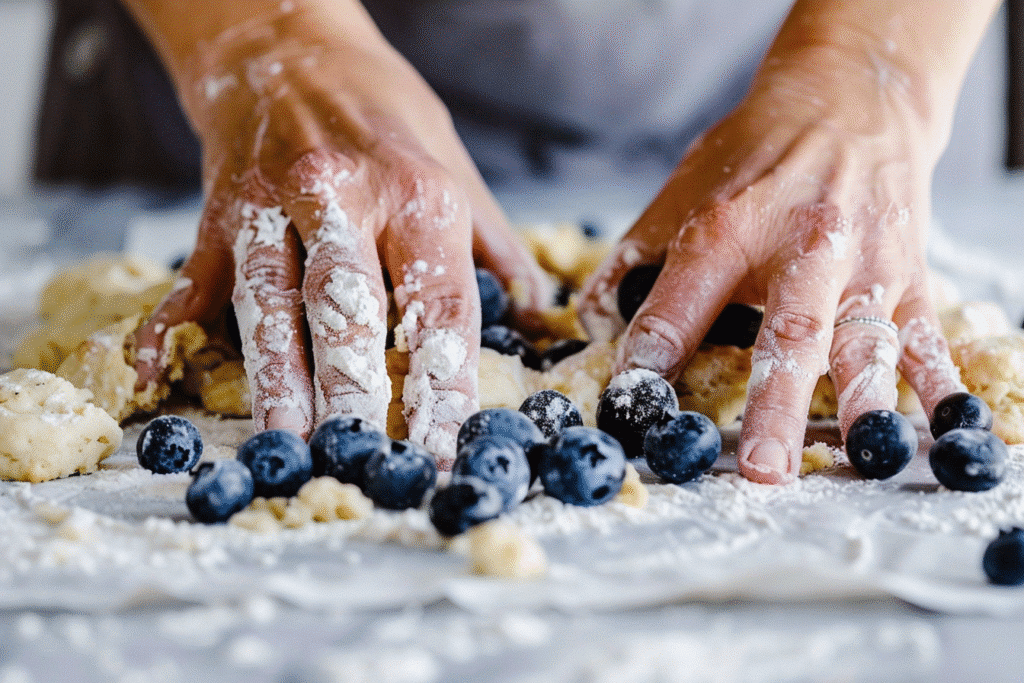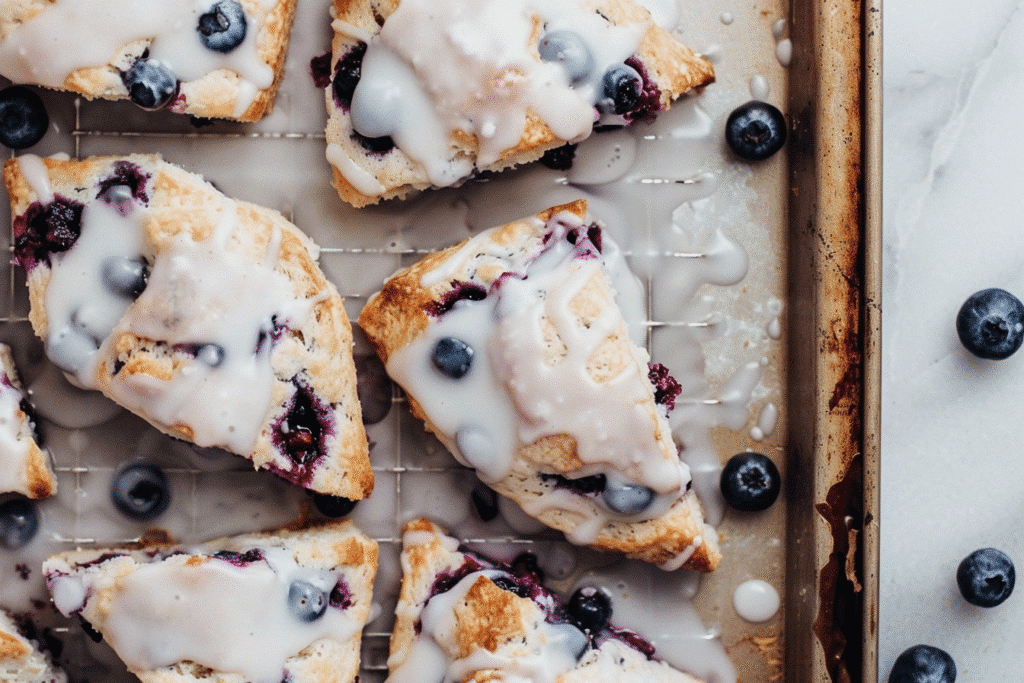There’s something comforting about pulling a tray of scones out of the oven, especially when they’re packed with bursting blueberries and warm, golden edges. In this article, I’ll walk you through how to make easy gluten free blueberry scones that are crisp outside, tender inside, and never dry or dense. Whether you’re new to gluten free baking or just want a reliable scone recipe that works, you’ll find tips, tricks, and a personal story baked right in. From flour blends to that famous 15-minute trick, let’s make scones you’ll actually crave.
The Story & Intro
Why These Gluten Free Blueberry Scones Mean So Much to Me
I’m Emma – the heart behind this site – and my journey with baking easy gluten free blueberry scones began in a snug kitchen in South London.
Back then, it was just me, a secondhand notebook, a phone full of food photos, and a craving for home comforts. I wasn’t trying to impress anyone—just trying to recreate the flavors I missed, in a way that worked for my gluten free life.
These scones were born from that craving: something warm, buttery, and crumbly that still felt like home. Now, even across the ocean in my U.S. kitchen, I bake them often—because every bite brings me back to those first quiet mornings filled with simple ingredients and big flavor.
Back then, I didn’t have fancy flour blends or xanthan gum—just basic rice flour, a handful of blueberries, and a hope that something like gluten free cottage cheese bagels could bring back that bakery-style comfort I missed. After so many attempts (and a few too-dry disasters), I finally found a balance that worked. These gluten free cottage cheese bagels gave me the golden tops, soft crumb, and those juicy, fruit-filled bites I had longed for. It’s amazing how one simple recipe brought the joy of warm, chewy baked goods back into my gluten-free life.
Now I keep a stash of these gluten free blueberry scones in the freezer for quick breakfast treats or tea with friends. They bring back memories of uni mates dropping in unannounced, and the smell of butter wafting through our tiny flat. If you’ve ever felt like you had to give up on the “real” scone experience after going gluten free, I promise—this recipe gives it back.
The Secret Behind Making Gluten Free Still Feel Like Home Baking
Gluten free baking doesn’t have to feel like settling. It’s all about the method—and the right flour. The balance of moisture, structure, and chill time makes or breaks these scones. And the best part? They’re simpler than they look. Whether you’re new to this or not, I’ll help you get it right.
I still remember the first time I tried baking something like these gluten free cottage cheese bagels—the dough didn’t rise, but the spirit stayed strong.
…Just like with many of our gluten free dairy free recipes, it’s all about finding balance, texture, and taste.
Mastering Gluten-Free Scones
Understanding Gluten-Free Flour Blends for Scones
If you’ve tried baking gluten free scones before and ended up with something dry, gummy, or oddly chewy, chances are the flour blend was the culprit. Traditional scones rely on wheat for structure and tenderness. When going gluten free, you need a blend that can mimic that without overpowering the scone’s delicate texture.
For these easy gluten free blueberry scones, I use a 1:1 all-purpose gluten free flour with xanthan gum already included. It’s the most consistent for structure without drying out. If your blend doesn’t include xanthan gum, add about ½ teaspoon per cup of flour to help bind the dough.
Avoid heavy flours like pure almond or coconut in this recipe—they absorb too much liquid and throw off the scone’s rise. A mix of rice flour, potato starch, and tapioca tends to work best. Keep your flour stored airtight and fresh. Old blends can behave unpredictably and cause crumbling.
And here’s the tip I wish I’d known sooner: weigh your flour instead of scooping. Even a few grams too much can lead to dense scones. Aim for around 140g of flour per cup when using a scale.
The mixing process is similar to what you’d do for a good gluten free biscuit recipe—cold fat, light hand, strong rise.
If you’re looking for a dairy-free version, our vegan gluten free recipes include excellent options using plant-based alternatives.

Easy Gluten Free Blueberry Scones That Actually Fluff and Crumble Right
- Total Time: 37 minutes
- Yield: 8 scones 1x
- Diet: Gluten Free
Description
These easy gluten free blueberry scones come out buttery, fluffy, and golden every time. A perfect weekend bake with simple pantry ingredients.
Ingredients
2 cups gluten free all-purpose flour (with xanthan gum)
1/4 cup granulated sugar
1 tbsp baking powder
1/2 tsp salt
1/2 cup unsalted butter, cold and cubed
2/3 cup heavy cream (or full-fat coconut milk)
1 egg
1 tsp vanilla extract
1 cup blueberries (fresh or frozen, unthawed)
Extra cream and sugar for topping
Instructions
1. Preheat oven to 400°F and line a baking sheet with parchment.
2. In a large bowl, whisk together flour, sugar, baking powder, and salt.
3. Add butter and use a pastry cutter to blend until crumbly.
4. In another bowl, mix cream, egg, and vanilla. Add to flour mix.
5. Gently fold in blueberries with a spatula.
6. Turn dough onto floured surface and shape into a circle, about 1 inch thick.
7. Cut into 8 wedges and place on baking sheet.
8. Brush tops with cream and sprinkle sugar.
9. Chill for 15 minutes, then bake for 20–22 minutes until golden.
10. Cool slightly before serving.
Notes
Use frozen blueberries straight from the freezer to avoid blue streaking.
Don’t skip the 15-minute chill—it gives scones lift and texture.
Best enjoyed the day they’re baked but freeze beautifully for later.
- Prep Time: 15 minutes
- Cook Time: 22 minutes
- Category: Breakfast, Baked Goods
- Method: Baking
- Cuisine: American, British
Nutrition
- Serving Size: 1 scone
- Calories: 240
- Sugar: 8g
- Sodium: 180mg
- Fat: 11g
- Saturated Fat: 7g
- Unsaturated Fat: 3g
- Trans Fat: 0g
- Carbohydrates: 32g
- Fiber: 2g
- Protein: 3g
- Cholesterol: 40mg
Keywords: easy gluten free blueberry scones, gf scones, blueberry scones
The Role of Fats and Liquids in the Perfect Crumb
In classic scones, cold butter cuts through flour to create flakey layers. In gluten free scones, this still works—but the fat-to-flour ratio is more sensitive. Use frozen grated butter or pea-sized chunks, and work them in just until crumbly. You want visible pieces left in the dough.
For liquids, heavy cream or full-fat coconut milk gives moisture and richness. Avoid thinner dairy-free milks unless you’re adding more fat elsewhere. And never skip chilling your dough before baking. A 15-minute freeze firms the butter, reduces spreading, and keeps the crumb light.
I often reach for frozen berries when prepping these easy gluten free blueberry scones—just like how I stock frozen fruit for my gluten free crepe recipe.
Want to explore more flexible dough recipes? These gluten free pitas are a reader favorite.
Baking With Blueberries (Fresh vs Frozen)
Which Berries Work Best in Scones
When baking easy gluten free blueberry scones, choosing the right type of blueberries can make all the difference. Fresh blueberries are a popular pick—and for good reason. They hold their shape well, add a natural sweetness, and won’t bleed into your gluten free scone dough. This makes them perfect when blueberries are in season, especially if you’re preparing scones for a brunch spread or special occasion.
That said, don’t underestimate the power of frozen blueberries in your easy gluten free blueberry scones. Frozen berries are picked at peak ripeness and are often more affordable and convenient all year round. The key is to use them straight from the freezer—never thawed. Thawed berries release too much juice, which can turn your gluten free dough into a sticky, streaky mess. To prevent this, lightly coat frozen blueberries in your gluten free flour blend before folding them in. This step keeps moisture under control and ensures the berries stay evenly distributed throughout the dough.
In my kitchen, I’ve baked these gluten free blueberry scones with both fresh and frozen berries many times. Fresh blueberries are my top choice for visual appeal, but frozen ones are my everyday go-to. Once baked and glazed, the difference in taste is almost impossible to tell.
Mastering gluten free structure is key—whether you’re baking scones or working with gluten free wonton wrappers, texture control is everything.
And much like with our gluten free ramen noodles, chilling the dough ensures a better shape and chew.
How to Keep Blueberries From Bleeding Into Your Dough

Blue streaks in scones aren’t just a visual thing—they can change the texture. Here’s how to prevent that “purple sponge” situation:
- Add blueberries at the very end.
- Don’t overmix. One or two folds is enough.
- Use a cold dough and chill it again if it starts warming up.
- Always line your tray—leaked juice can caramelize and stick.
One of my favourite kitchen tricks? Use a bench scraper instead of your hands when shaping the dough. Hands warm the butter and crush the berries. A scraper keeps things cool and controlled.
Want more fruity bakes that balance moisture and structure just right? Try these raspberry almond breakfast bars that hold up even with juicy fruit.
Secrets and Fixes for Scone Success
Common Mistakes in Gluten Free Scone Baking
Gluten free baking can feel like a puzzle until you understand how a few small steps affect the final result. If your scones have ever turned out tough, flat, or crumbly, one of these common issues might be the cause:
- Overmixing the dough: Gluten free flours don’t have the same elasticity, so too much stirring creates gummy textures instead of flakey layers.
- Too much flour: Always spoon and level your flour or use a kitchen scale. Too much will suck out the moisture.
- Warm butter: If the butter isn’t cold, the dough loses structure. You need little cold bits that melt in the oven and create steam—this is what makes scones rise and flake.
- Not chilling before baking: This is especially important for gluten free scones. A short chill helps them hold shape and rise taller.
Another pitfall? Using baking powder that’s lost its lift. If yours is older than 6 months, replace it. The chemical reaction is key for that classic scone height.
You can read more in our Gluten Free Baking Mistakes to Avoid where I break down the top five recipe flops and how to fix them.
The 15-Minute Rule and How It Changes Everything

Here’s a trick that works like magic: after shaping your scones, chill them in the freezer for 15 minutes before baking. It may seem like a throwaway step—but it changes everything.
The science is simple. Cold butter + hot oven = steam. Steam puffs up the dough, gives you lift, and creates that crisp-on-the-outside, soft-in-the-middle crumb. Skip this step, and your scones may spread out and flatten.
If your kitchen is warm or you’re working slowly, don’t hesitate to pop the dough into the fridge between steps. In fact, during summer, I shape the dough between two sheets of parchment and refrigerate the whole slab before cutting.
This trick works across the board—try it with our chocolate chip almond scones for the same lift and snap.
FAQs About Easy Gluten Free Blueberry Scones

What is the 15-minute rule for easy gluten free blueberry scones?
The 15-minute rule is a game-changer when baking easy gluten free blueberry scones. After shaping your dough into wedges, chill it in the fridge or freezer for at least 15 minutes before baking. This step keeps the butter cold, which creates steam in the oven. That steam is what gives these gluten free scones their soft, flaky layers and golden rise. It’s especially important in gluten free baking, where structure is more delicate.
What’s the secret to making perfect gluten free blueberry scones?
The secret to perfect gluten free blueberry scones is simple: cold ingredients, gentle handling, and the right balance of fat and flour. Always use a gluten free flour blend that includes xanthan gum, and keep your butter cold until baking time. Avoid overmixing the dough. Letting the scone dough chill for 15 minutes before baking helps it hold its shape and creates that bakery-style texture every time.
What common mistakes should I avoid when making easy gluten free blueberry scones?
A few small missteps can ruin your gluten free blueberry scones. Avoid overmixing the dough—this can make them dense or gummy. Don’t let the butter melt while working. Skipping the 15-minute chill is another common issue; it causes scones to spread flat. Also, don’t overload with flour—always weigh it for accuracy. Choosing the wrong flour blend or using one without a binder like xanthan gum can also lead to crumbly or dry results.
Should I use fresh or frozen blueberries for gluten free scones?
You can use either fresh or frozen blueberries in gluten free scones, but frozen berries are often more practical and consistent. For best results in easy gluten free blueberry scones, add frozen blueberries straight from the freezer and toss them with a bit of flour before mixing. This helps prevent bleeding and soggy dough. Fresh blueberries are great for a cleaner look, but both give excellent flavor in these homemade gluten free scones.
Conclusion
Making easy gluten free blueberry scones doesn’t mean settling for dry or crumbly results. With the right flour, cold butter, a gentle touch, and that 15-minute chill, you’ll get bakery-style scones every single time. Whether you’re using fresh berries or frozen, this recipe brings comfort and flavor with every bite. Bake them once, and you’ll want to keep a batch in the freezer—just in case.
Want more inspiration beyond these gluten free cottage cheese bagels?
Join our growing food-loving community on Facebook, where we share everyday kitchen wins, behind-the-scenes recipe tests, and personal stories from home cooks like you.
And if you love discovering creative gluten-free meals, follow us on Pinterest. From breakfast favorites to quick dinners, our boards are full of ideas to keep your meals easy, healthy, and satisfying.
Let’s cook together—one simple recipe at a time.

